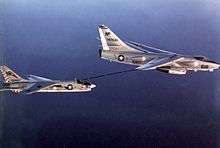Douglas A-3 Skywarrior
The Douglas A-3 Skywarrior was a jet-powered strategic bomber that was developed and produced by the Douglas Aircraft Company.
| A-3 (A3D) Skywarrior | |
|---|---|
 | |
| Role | Strategic bomber |
| National origin | United States |
| Manufacturer | Douglas Aircraft Company |
| First flight | 28 October 1952 |
| Introduction | 1956 |
| Retired | 27 September 1991 |
| Status | Retired |
| Primary user | United States Navy |
| Produced | 1956–1961 |
| Number built | 282 |
| Developed into | Douglas B-66 Destroyer |
It was designed by Douglas on behalf of the United States Navy, which sought a carrier-capable strategic bomber. During July 1949, Douglas was awarded the contract to produce its design, having bested eight other aircraft companies' submissions. Unlike rival designs, which had aimed for a 100,000 lb (45,000 kg) maximum take-off weight, the Skywarrior was developed for a 68,000 lb (31,000 kg) take-off weight, facilitating its use from the navy's existing Midway-class aircraft carriers. Large portions of the aircraft were produced by the Westinghouse Electric Corporation, including its early Westinghouse J40 turbojet engines, which failed to meet promises and were replaced by the rival Pratt & Whitney J57 engine by mid-1953. On 28 October 1952, the prototype XA3D-1 performed the type's maiden flight.
On 31 March 1956, the Skywarrior entered squadron service with the Navy. Initially used in the nuclear-armed strategic bomber role, the emergence of effective ballistic missiles led to this mission being deprioritised by the early 1960s. Throughout the majority of its later service life, the Skywarrior was tasked with various secondary missions, which included use as an electronic warfare platform, tactical reconnaissance aircraft, and high capacity aerial refueling tanker.[1] It was among the longest serving carrier-based aircraft in history, having entered service during the mid-1950s and withdrawn from use in 1991. Throughout its service, the Skywarrior was the heaviest operational aircraft to operate from an aircraft carrier,[2] which contributed to its nickname of "Whale".
The Skywarrior is one of only two U.S. Navy attack aircraft intended as a strategic bomber to enter full-scale service, the other being its predecessor, the North American AJ Savage. The carrier-based supersonic North American A-5 Vigilante was also originally designed for strategic nuclear strike missions and initially, very briefly, supplanted the A-3 in that role beginning in the early 1960s. A modified derivative of the Skywarrior, the B-66 Destroyer, served in the United States Air Force, where it was operated as a tactical bomber, electronic warfare aircraft, and aerial reconnaissance platform up until its withdrawal during the 1970s.
Development
Background
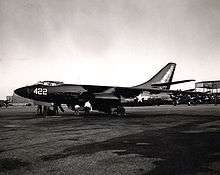
During World War II, the United States Navy (USN) began to explore the concept of operating jet-powered aircraft from its aircraft carriers. Success encouraged further development of the concept; early in the post-war years, officials within the USN began to investigate the use of jet power as a potential means of operating larger carrier-based aircraft that would be capable of performing the strategic bombing mission. The USN had a growing awareness that it could operate in a broader role that had been previously possible, and that the strategic bomber fleet operated by the United States Air Force (USAF) was unable to reach large parts of the world, a limitation that was not present upon its aircraft carrier fleet and their air wings.[3]
In January 1948, the Chief of Naval Operations issued a requirement to develop a long-range, carrier-based attack plane that could deliver either a 10,000 lb (4,500 kg) bomb load or a nuclear weapon.[4] The envisioned aircraft was intended to be operated from the planned United States-class "supercarriers," which were significantly larger than the USN's existing carriers, thus the specification set a target loaded weight of 100,000 lb (45,000 kg). Additionally, the USN sought for this bomber to possess greater speed and range than its existing North American AJ Savage fleet.[3] A total of eight aircraft manufacturers produced responses to the specification, but all except Douglas Aircraft Company and Curtiss-Wright would drop out, declaring that there was no means that the requirements could be met within the 100,000 lb weight limitation.[5] Uncertainty over the performance and requirements of both engines and bombs were major contributing factors towards this climate of negativity.[5]
Ed Heinemann, Douglas' chief designer, later to win fame for the A-4 Skyhawk, fearing that the United States class was vulnerable to cancellation, proposed a significantly smaller aircraft of 68,000 lb (31,000 kg) loaded weight, capable of operating from the USN's existing carriers.[6][7] Heinemann had reasoned (correctly) that as technology developed, the size and weight of nuclear weapons would substantially decrease, which increased the rationale for designing a more compact bomber.[8] However, figures such as USAF general Hoyt Vandenberg ridicules Heinemann's proposal as "making irresponsible claims".[5] During this period, the USN and USAF were vigorous rivals, each seeking to maintain funding for its projects at the expense of the other in a time marked by drastically declining defense budgets; specifically, USAF officials frequently voiced their open opposition to the construction of the United States-class carriers.[3]
Selection
During late 1948, both Douglas and Curtiss-Wright were awarded preliminary design contracts to further develop and refine their proposals.[5] While Douglas managed to maintain the take-off weight at 68,000 lb, Curtiss were unable to meet the more generous 100,000 lb target during this phase, and thus were eliminated from consideration. During April 1949, the USN's critics succeeded in getting the United States-class carriers cancelled; this outcome validated Heinemann's decision to focus on a design that could operate from the navy's smaller Midway-class aircraft carriers.[5] During July 1949, the USN, recognizing the suitability of Douglas' design, awarded a contract for the production of two flight-capable prototypes and a single static airframe to the company.[5]
Douglas sourced significant portions of the aircraft, including responsibility for the turbojet engines, radar, tail-mounted turret, electrical generators and various other secondary systems, from the Westinghouse Electric Corporation; this heavy reliance on Westinghouse allegedly caused to some discomfort to Douglas.[5] In particular, development of the Westinghouse J40 engine proved to be incapable of meeting development schedules or performance promises; Heinemann later commented that "the first thing we learned was that the J40 was not powerful enough".[9] Even prior to the first flight being conducted, Douglas was considering switching to rival manufacturer Pratt & Whitney's J57 engine, which was heavier, but allowed the overall aircraft to be lighter due to being less fuel hungry.[10]
On 28 October 1952, the prototype XA3D-1 performed the type's maiden flight; flown by George Jansen, this initial test flight was carried out with a high degree of secrecy. Early on, the aircraft was found to handle particularly well in flight, in part due to the attention Heinemann and the design team had paid to the hydraulically-boosted control surfaces.[9] On 16 October 1953, the first YA3D-1, powered by the rival J57 engine, made its first flight.[11]
Considerable development problems, largely associated with the original J40 engines, had delayed the introduction of the Skywarrior until 31 March 1956.[11] The A-3 was, by far, the largest and heaviest aircraft ever designed for routine use on an aircraft carrier, though ironically it was the smallest proposal among other proposals that could only be deployed on even larger carriers not yet in service.[4] As had been predicted by Heinemann early on, the Skywarrior had been designed to carry larger and bulkier bombs that it ever would in service due to the rapid improvements made in weapons technology.[11] Despite this, at the Navy's insistence, the aircraft was qualified for an 'overload' payload capacity of 84,000 lb (38,000 kg), the testing of which would establish a weight-related record for carrier operations.[11] Because of its cumbersome size, and less-than-slender profile, it was nicknamed "The Whale".[12]
By the end of the 1950s, it was becoming clear that the nuclear mission of the Skywarrior would be passed onto ballistic missiles; however, its high weight clearance and size meant that the aircraft would be useful in various other capacities.[13] Accordingly, large numbers of Skywarriors were retrofitted as aerial refuelling tankers or as electronic warfare platforms; notably, the EKA-3B model could readily swing between performing strike, refuelling, and electronic warfare duties as required. Numerous other models of the type were developed, leading to the type being used for aerial reconnaissance and as a trainer aircraft as well.[14] Production of the type ceased in 1961.
Design
The Skywarrior had a 36° degree swept wing and two Pratt & Whitney J57 turbojet engines. Early prototypes had used the intended Westinghouse J40, a powerplant that proved to be disastrous and was subsequently canceled. The turbojets could be supplemented by a provision for twelve 4,500 lbf (20 kN) thrust JATO bottles. The aircraft had a largely conventional semi-monocoque fuselage, with the engines in underwing nacelles. Flight controls were hydraulic, and for storage below deck, the A-3's wings folded outboard of the engines, lying almost flat, and its vertical stabilizer was hinged to starboard.[4] Capacious internal fuel tanks provided long range.

The early A-3 variants had a crew of three: pilot, bombardier/navigator (BN) and crewman/navigator (aka: third crewman). An unusual cockpit configuration was incorporated with the three crew sitting under a framed canopy. In the raised compartment, the pilot and bombardier/navigator sat in a side-by-side arrangement with the pilot's station on the port side having full flight controls. On initial variants, a third crew member, who also acted as a gunner for the twin tail-mounted 20mm cannon that briefly equipped the original bomber version of the A3D/A-3A (removed and replaced by ECM equipment), sat behind the pilot in an aft-facing seat. The third crewman station had the sextant for celestial navigation and the defensive electronic counter measures equipment. Later electronic reconnaissance variants could accommodate a crew of seven with the flight crew consisting of a pilot, co-pilot and navigator plus four electronic systems operators occupying stations in the former bomb bay in the spacious fuselage.[4]
Efforts to reduce weight to make the aircraft suitable for carrier operations had led to the deletion of ejection seats during the design process for the Skywarrior, based on the assumption that most flights would be at high altitude. A similar arrangement with an escape tunnel had been used on the F3D Skyknight.[15] Aircrews began joking morbidly that "A3D" stood for "All Three Dead".[16] (In 1973, the widow of a Skywarrior crewman killed over Vietnam sued the McDonnell Douglas Aircraft Company for not providing ejection seats in the A-3.[15]) In contrast, the US Air Force's B-66 Destroyer, not subject to the weight requirements for carrier operations, was equipped with ejection seats throughout its service life.
The documented history of mechanical failures in the A3D / A-3 showed a rate well above average. While there were magazine articles that conjectured that the safety problem was compounded by assigning weaker pilots to slower jets like the A-3, during their heyday, Skywarrior pilots were often "best-of-the-best" and were, with few exceptions, senior pilots with a minimum of 1,500 hours jet time, due to its critical nuclear strike mission and the difficulty of bringing such a large plane aboard, especially at night on the smaller carriers. Originally, the Skywarrior bombers were assigned to all attack carriers, which included: the World War II-era Essex class and the (just) postwar Midway class.[17]
The Skywarrior could carry up to 12,000 lb (5,400 kg) of weaponry in the fuselage bomb bay, which in later versions was used for sensor and camera equipment or additional fuel tanks. An AN/ASB-1A bomb-director system was initially installed, later replaced by a revised AN/ASB-7 with a slightly reshaped nose. Defensive armament was two 20mm cannons in a radar-operated tail turret designed by Westinghouse, soon removed in favor of electronic counter measure equipment. Although some bombing missions would be carried out early in the Vietnam War, most bombing would be carried out by more nimble attack and fighter bombers, and the Skywarrior would serve mostly as a tanker and electronic warfare support aircraft.
Operational history
Nuclear bomber
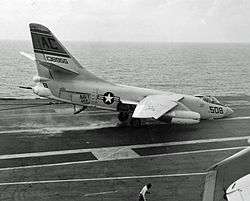
Prior to the initial operational capability of the U.S. Navy's Polaris-armed Fleet Ballistic Missile submarines, the A-3 was the Navy's critical element in the U.S. nuclear deterrent. Squadrons were established in two Heavy Attack Wings (HATWINGs), with one wing initially established at NAS North Island, California before relocating to NAS Whidbey Island, Washington in December 1957 while the other wing was initially established at NAS Jacksonville, Florida before relocating to NAS Sanford, Florida. The wing at NAS Whidbey Island would disestablish in 1959 but the squadrons which had made up the wing would later transition to the EKA-3B variant, eventually forming the nucleus for the Navy's Grumman EA-6B Prowler community, while the wing at NAS Sanford would convert to the A3J Vigilante (later A-5A) in the nuclear heavy attack mission, followed by conversion to the RA-5C and transition to the reconnaissance attack mission. The Vigilante wing would also continue to retain a small number of TA-3B aircraft for training Naval Flight Officers in the Vigilante's radar and navigation systems. The Skywarrior's strategic bombing role faded after 1964, briefly being complemented by the A3J Vigilante. Soon afterward, the Navy abandoned the concept of carrier-based strategic nuclear weaponry for the successful Polaris missile-equipped Fleet Ballistic Missile submarine program and all A-5As were converted to the RA-5C Vigilante reconnaissance variant. Many A-3Bs were converted to a combination tanker-electronic warfare aircraft.
Vietnam War era
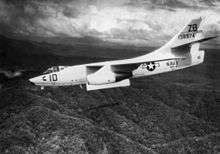
_flight_deck_1967.jpeg)
Skywarriors saw some use in the conventional bombing and mine-laying role (A-3B) during the Vietnam War from 1964 through 1967, often to deliver Mk84 2,000 pounds (910 kg) bombs. The A-3 found subsequent service in the tanker (KA-3B), photographic reconnaissance (RA-3B), electronic reconnaissance (EA-3B), and electronic warfare (ERA-3B, EKA-3B) roles.
For most of the Vietnam War, EA-3Bs of Fleet Air Reconnaissance Squadron 1 (VQ-1) flew from Da Nang Air Base in South Vietnam, providing continuous electronic reconnaissance capability over the area, including the Ho Chi Minh Trail and all the way north to Haiphong harbor. This was known as VQ-1 Det.B. The aircrew and ground support personnel were temporarily assigned from their home base at NAS Atsugi, Japan and after 1970, NAS Agana, Guam. After Det B was disestablished, VQ-1 provided detachments of two EA-3B aircraft that deployed with Western Pacific and Indian Ocean (WESTPAC/IO) bound aircraft carrier battle groups up until the late 1980s when it was replaced by the Lockheed ES-3A Shadow.
In addition, a version of the A-3B was modified into the RA-3B and used in Vietnam as a photo reconnaissance aircraft.[18] Heavy Photographic Squadron 61 (VAP-61) at NAS Agana, Guam and sister squadron VAP-62 at NAS Jacksonville, Florida furnished crews and flew out of Da Nang AB performing mapping and intelligence gathering flight over the Southeast Asia area. With 12 camera stations the RA-3B was well equipped to perform cartographic mapping of areas where no detail maps existed. With IR gear installed, the RA-3B was used at night to monitor the movement of troops down roads and trails in Laos. Other locations included Det Tango at Don Muang Royal Thai Air Force Base in Bangkok, Thailand, Det Southpaw at RAAF Base Townsville, Australia, as well as work out of Osan Air Base, South Korea.
Tanker role
During the Vietnam War, the A-3 attack aircraft were modified to KA-3B tankers while some were modified into a multi-mission tanker variant, the EKA-3B, which was a real workhorse for the carrier air wing. Electronic jamming equipment was added without removing tanker capability so the EKA-3B could jam enemy radar while waiting to refuel tactical aircraft.[19] Eventually, the EKA-3B was replaced by the smaller dedicated Grumman KA-6D Intruder tanker, which although it had less capacity and endurance, was deployed in greater numbers within the carrier's air wing. Two additional Naval Reserve units were established in the early 1970s as air refueling squadrons, VAQ-208 and VAQ-308, at NAS Alameda, California. Both units operated aircraft with electronic warfare equipment removed and were redesignated as KA-3Bs. VAK-208 and VAK-308 were decommissioned in the early 1990s.
Cold War
The EA-3 variant was used in critical electronic intelligence (ELINT) roles operating from aircraft carrier decks and ashore supplementing the larger Lockheed EP-3. Its last service was as an ELINT platform during Desert Storm.
Reconnaissance
The EA-3B variant was modified for electronic intelligence against the Warsaw Pact. Missions were flown around the globe beginning in 1956, with the U.S. Air Force EB-47 Stratojet flying a similar mission. The EA-3B carried a crew of seven, with flight crew of three in the cockpit and an Electronic Warfare Officer and three electronic systems operators/evaluators in the converted weapons bay. It offered unique electronic reconnaissance capabilities in numerous Cold War-era conflicts and the Vietnam War.[20]
Retirement
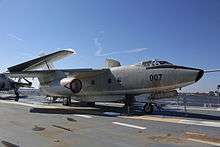
A handful of EA-3Bs remained in service long enough to participate in the first Gulf War in 1991.[21] The Skywarrior was withdrawn from USN service during September 1991, the last examples of the type being retired on 27 September 1991. U.S. Navy RDT&E units, notably Naval Air Systems Command (NAVAIR) activities at NAS Point Mugu and NAWS China Lake, attempted to retain their A-3 testbeds. These ambitions were ultimately unsuccessful when Vice Admiral Richard Dunleavy, as Deputy Chief of Naval Operations for Air Warfare and a former A-3 bombardier/navigator himself, made the final decision to retire the type.
Post-retirement career
The A-3 had been used as a civilian operated testbed for many years before the type's retirement from US Navy, with Hughes Aircraft Company using the type as a testbed for developing the weapons system for the General Dynamics–Grumman F-111B and Grumman F-14 Tomcat, with Westinghouse and Raytheon also using the A-3 as a testbed.[22] On the retirement of the type from US Navy service in 1991, the US Navy decided to end logistic support for the civilian operated testbeds. Rather than abandon the A-3, Hughes, Westinghouse and Raytheon agreed to acquire the remaining A-3s and spares from the Navy, allowing their test fleets to continue to operate and saving the US Navy the cost of storage and disposal. As the plan matured, two other contractors, Thunderbird Aviation and CTAS also elected to participate in similar agreements, with eleven A-3s spread between the five operators.[23] The fleet spares from ASO (Aviation Supply Office) were distributed between the contractors evenly, and warehouses were emptied all over the US. Due to misunderstandings and reorganizations within the US Navy, the worldwide ASO assets were scrapped, not getting to the contractors. In early 1993, CTAS decided that they no longer had use for their aircraft, and Hughes had several programs needing additional assets.
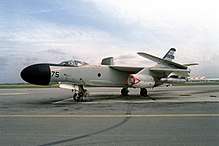
In early 1994, a US Air Force program decided to modify an A-3 for F-15 radar tests, and the only available airframe was stored at NAS Alameda since the fleet shutdown. Hughes added that aircraft to the bailment, and ferried the aircraft to Van Nuys for modifications. An entire nose section was removed from a stricken F-15B at AMARC at Davis-Monthan AFB, Arizona and grafted onto the front of the aircraft. Racks and equipment were installed in the cabin, and the aircraft was used by Hughes and the USAF for F-15 software development.
In 1994, Westinghouse decided to terminate their agreement with the Navy, and Thunderbird added their aircraft to the Thunderbird bailment. In 1996, Thunderbird Aviation went into receivership, and Hughes, through mutual cost savings to the government, added the Thunderbird assets to the contract, prepping them for ferry at Deer Valley airport, and relocating them to Mojave, California and Tucson, Arizona for long-term storage.
In December 1996, Raytheon bought the aerospace units of Hughes Aircraft Company. Hughes Aeronautical Operations, now a part of Raytheon Systems, continued to operate the A-3s from their base at Van Nuys Airport, California.[24] These aircraft have participated in several military air shows, telling visitors that the plane continued to be valuable for its load capacity compared to corporate jets, and its performance compared to small airliners.
On 30 June 2011, the last flyable EA-3B, BuNo 144865 / FAA registration N875RS[25], a Raytheon aircraft, arrived at NAS Pensacola, Florida for retirement and display at the National Naval Aviation Museum.
Variants
%2C_circa_in_1957.jpg)
Note: under the original Navy designation scheme, the Skywarrior was designated A3D (third Attack aircraft from Douglas Aircraft). In September 1962, the new Tri-Services designation system was implemented and the aircraft was redesignated A-3. Where applicable, pre-1962 designations are listed first, post-1962 designations in parentheses.
- XA3D-1: Two prototypes with Westinghouse J40 turbojets, no cannon in tail turret.
- YA3D-1 (YA-3A): One pre-production prototype with Pratt & Whitney J57 engines. Later used for tests at the Pacific Missile Test Center.
- A3D-1 (A-3A): 49 initial production versions, serving largely in developmental role in carrier service.
- A3D-1P (RA-3A): One A3D-1 converted as a prototype for the A3D-2P with camera pack in the weapon bay.
- A3D-1Q (EA-3A): Five A3D-1s converted for the electronic reconnaissance (ELINT) role, with ECM equipment and four operators in weapons bay.
- A3D-2 (A-3B): Definitive production bomber version, with stronger airframe, more powerful engines, slightly larger wing area (812 ft²/75 m² versus 779 ft²/72 m²), provision for in-flight refueling reel for tanker role. Final 21 built had new AN/ASB-7 bombing system, reshaped nose; deleted tail turret in favor of electronic warfare installation.
- A3D-2P (RA-3B): 30 photo-reconnaissance aircraft with weapons bay package for up to 12 cameras plus photoflash bombs. Increased pressurization allowed camera operator to enter the bay to check the cameras. Some retained tail guns, but most were later converted to ECM tail of late A-3Bs.
- A3D-2Q (EA-3B): 24 electronic warfare versions with pressurized compartment in former weapon bay for one Electronic Warfare Officer and three ESM operators, various sensors. Some early models had tail guns, but these were replaced with the ECM tail. It was assigned to fleet reconnaissance squadrons VQ-1 (Japan and later Guam) and VQ-2 (Rota. Spain) where they flew alongside the Lockheed EC-121 Warning Star and the EP-3B and EP-3E. It served for almost 40 years, being the longest serving variant, and was replaced by the ES-3A Shadow flown by two Fleet Air Reconnaissance (VQ) squadrons: VQ-5 at NAS North Island, California and VQ-6 at NAS Cecil Field, Florida. They were decommissioned due to budget constraints less than 10 years after commissioning.
- A3D-2T (TA-3B): 12 bomber-trainer versions. Five later converted as VIP transports (two redesignated UTA-3B).
- KA-3B: 85 A-3B bombers refitted in 1967 for the tanker role with probe-and-drogue system in place of bombing equipment.
- EKA-3B: 34 KA-3B tankers refitted for dual Electronic countermeasures (ECM)/tanker role, with electronic warfare equipment and tail fairing in place of rear turret. Most were converted back to KA-3B configuration (with no ECM gear) after 1975.
- ERA-3B: Eight RA-3Bs converted as electronic aggressor aircraft (primarily for war-at sea exercises) with ECM gear in an extended tail cone and fairings, along with two detachable ram-air turbine powered ALQ-76 countermeasures pods (one under each wing), chaff dispensers (on the tail cone and aft fuselage) and four ram-air turbines (two per side) to power equipment located in the former bomb bay. Crew increased to four: pilot, navigator, crew chief, and Electronic Countermeasures Officer (ECMO) with one mostly unused "jumpseat" in the aft crew compartment (the former weapon bay) which lacked an equipment position for a second Electronic Countermeasures Officer or enlisted crewman. The "jump seat" was used by instructor ECMOs training new ECMOs, as well as by guest observers and passengers during operational flights. While the ERA-3B could withstand a cable-arrested landing, the ALT-40 and ALR-75 equipment was not stressed to withstand catapult launches, thus it was never deployed aboard carriers. The ERA-3B served with VAQ-33 and later with VAQ-34.
- NRA-3B: Six RA-3Bs converted for various non-combat test purposes.
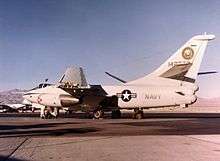
- VA-3B: Two EA-3B converted as VIP transports. Both aircraft were assigned to the Chief of Naval Operations flying from Andrews AFB in Washington, DC.
- NTA-3B: One aircraft converted by Hughes/Raytheon used to test radar for the F-14D Tomcat.
B-66 Destroyer
The U.S. Air Force ordered 294 examples of the derivative B-66 Destroyer, most of which were used in the reconnaissance and electronic warfare roles. The Destroyer was fitted with ejection seats.
Operators
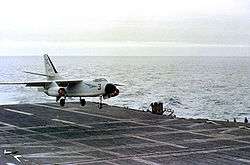
- United States Navy
- VAH-1 based at NAS Sanford, FL (later RVAH-1, now decommissioned)
- VAH-2 based at NAS Whidbey Island, WA (now VAQ-132)
- VAH-3 based at NAS Sanford, FL (later RVAH-3, now decommissioned); Replacement Air Group / Fleet Replacement Squadron
- VAH-4 based at NAS Whidbey Island, WA (now VAQ-131)
- VAH-5 based at NAS Sanford, FL (later RVAH-5, now decommissioned)
- VAH-6 based originally at NAS North Island, CA,
moved to NAS Whidbey Island, WA 1958, then moved to NAS Sanford, FL
(later RVAH-6, now decommissioned) - VAH-7 based at NAS Sanford, FL (later RVAH-7, now decommissioned)
- VAH-8 based at NAS Whidbey Island, WA (now decommissioned)
- VAH-9 based at NAS Sanford, FL (later RVAH-9, now decommissioned)
- VAH-10 based at NAS Whidbey Island, WA (now VAQ-129)
- VAH-11 based at NAS Sanford, FL (later RVAH-11, now decommissioned)
- VAH-13 commissioned at NAS Sanford, FL, moved to NAS Whidbey Island, WA 1961
(later RVAH-13, now decommissioned) - VAH-123 based at NAS Whidbey Island, WA (now decommissioned)
- VAQ-129 based at NAS Whidbey Island, WA (later flying the EA-6B, now flying the EA-18G); Fleet Replacement Squadron
- VAW-13 based at NAS Whidbey Island, WA (now VAQ-130 flying the EA-18G)
- VAQ-131 based at NAS Whidbey Island, WA (now flying the EA-18G)
- VAQ-132 based at NAS Whidbey Island, WA (now flying the EA-18G)
- VAQ-133 based at NAS Whidbey Island, WA (now flying the EA-18G)
- VAQ-134 originally based at NAS Alameda, CA moved to NAS Whidbey Island, WA (now flying the EA-18G)
- VAQ-135 based at NAS Whidbey Island, WA (now flying the EA-18G)
- VAQ-33 based at NAS Key West, FL (now decommissioned)
- VAQ-34 based at NAS Point Mugu, CA (now decommissioned)
- VAK-208 based at NAS Alameda, CA (now decommissioned) (Naval Air Reserve)
- VAK-308 based at NAS Alameda, CA (now decommissioned) (Naval Air Reserve)
- VAP-61 based at NAS Agana, Guam (now decommissioned).
- VAP-62 based at NAS Jacksonville, Florida (now decommissioned)
- VCP-63, later VFP-63, based at NAS Miramar, CA flying five A3D-2P Skywarriors and twenty F8U-1P Crusaders
- VQ-1 based at NAS Agana, Guam (now based at NAS Whidbey Island, WA flying only the EP-3E)
- VQ-2 based at NS Rota, Spain (later based at NAS Whidbey Island, WA flying only the EP-3E; now decommissioned)
- VR-1 based at NAS Patuxent River, MD and Andrews AFB/NAF Washington, MD
- VX-5 based at NAWS China Lake, CA with detachment at NAS Sanford, FL
- National Parachute Test Range based at NAF El Centro, CA
- Naval Air Development Center based at NADC Johnsville/NADC Warminster, PA (activity and installation now decommissioned)
- Naval Air Test Center at NAS Patuxent River, MD
- Pacific Missile Test Center at NAS Point Mugu, CA
Surviving aircraft
- On display
- XA3D-1
- 125413 – Fulton County Airport, Johnstown, New York.[26]
- A-3A
- 135434 – Restored in September 2011 by members of Naval Air Reserve Patrol Squadron 65 (VP-65) based at Naval Air Station Point Mugu. Aircraft displayed at the Edwards Air Force Flight Test Center Museum, Edwards AFB, California.[27]
- NA-3A
- 135418 – National Naval Aviation Museum, NAS Pensacola, Florida.[28]
- YEA-3A
- 130361 – Pima Air and Space Museum (adjacent to Davis-Monthan AFB), Tucson, Arizona.[29]
- A-3B
- EA-3B
- 146448 – National Cryptologic Museum, National Vigilance Park, Fort Meade, Maryland.[31]
- 146457 – Patriots Point Naval and Maritime Museum, Mount Pleasant, South Carolina (previously displayed in front of Daum Hall Bachelor Officers Quarters, Naval Station Rota, Spain).[32][33]
- 144865 - National Naval Aviation Museum, Naval Air Station Pensacola, Florida[34] (last flyable A-3 Skywarrior)
- KA-3B
- 138944 – U.S.S. Lexington Museum, Corpus Christi, Texas.[35]
- 147648 – NAS Key West, Boca Chica Key, Florida.[36]
- 147666 – Oakland Aviation Museum in Oakland, California.[37]
- NA-3B
- 142630 – Celebrity Row, Davis-Monthan AFB, Tucson, Arizona.[38]
- EKA-3B
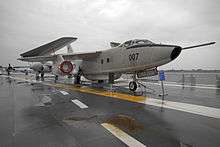
- 142251 – USS Midway Museum, San Diego, California.[39]
- NEA-3B
- 144865 – National Naval Aviation Museum, NAS Pensacola, Florida.[40]
- NRA-3B
- 144825 – A-3 Skywarrior Whidbey Memorial Foundation, NAS Whidbey Island, Washington.[41]
- Under Restoration
- EA-3B

- 146453 – Vintage Flying Museum, Meacham Field, Fort Worth, Texas.[42]
- KA-3B
- 138965 – Yanks Air Museum, Chino, California.[43]
- ERA-3B
- 144843 – Castle Air Museum (former Castle AFB), Atwater, California.[44]
- NTA-3B
- 144867 – Pacific Aviation Museum, Pearl Harbor, Honolulu, Hawaii.[45]
Specifications (A3D-2/A-3B Skywarrior)
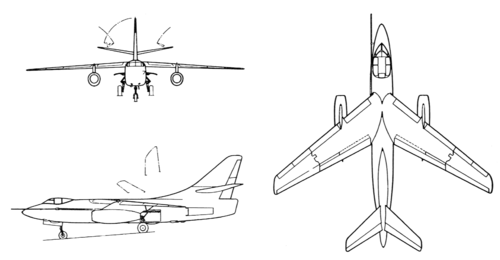
Data from McDonnell Douglas aircraft since 1920 : Volume I[46]
General characteristics
- Crew: 3
- Length: 76 ft 4 in (23.27 m)
- Wingspan: 72 ft 6 in (22.10 m)
- Height: 22 ft 9.5 in (6.947 m)
- Wing area: 812 sq ft (75.4 m2) with slats and CLE from A3D-2/A-3B
- Airfoil: root: NACA 63-009.9 (modified - {cambered leading edges}); tip: NACA 63-008.25 (modified - {cambered leading edges})[47]
- Empty weight: 39,409 lb (17,876 kg)
- Gross weight: 70,000 lb (31,751 kg)
- Max takeoff weight: 82,000 lb (37,195 kg)
- Powerplant: 2 × Pratt & Whitney J57-P-10 turbojet engines, 10,500 lbf (47 kN) thrust each dry
- 12,400 lbf (55 kN) with water injection[48]
Performance
- Maximum speed: 530 kn (610 mph, 980 km/h) at 10,000 ft (3,000 m)
- Cruise speed: 520 kn (600 mph, 960 km/h)
- Range: 1,825 nmi (2,100 mi, 3,380 km)
- Ferry range: 2,520 nmi (2,900 mi, 4,670 km)
- Service ceiling: 41,000 ft (12,000 m)
- g limits: +3.4
- Wing loading: 86.2 lb/sq ft (421 kg/m2)
- Thrust/weight: 0.357
Armament
- Guns: 2 20 mm M3L cannon in the tail turret[49]
- Bombs: 12,800 pounds (5,800 kg) of free-fall bombs or mines,[49] including any combination of[16]
- 12 500 pounds (230 kg) Mark 82 bombs or
- 6 1,000 pounds (450 kg) Mark 83 bombs or
- 8 1,600 pounds (730 kg) armor-piercing bombs or
- 4 2,000 pounds (910 kg) bombs
- 1 free-fall nuclear weapon
Avionics
- AN/ASB-1A (early radar)
- AN/ASB-7 bomb-director
- Defensive electronic countermeasure gear
See also
Related development
Aircraft of comparable role, configuration and era
Related lists
References
Citations
- Winchester 2006, p. 74.
- the heaviest aircraft operated from a carrier was a USMC KC-130F used in a test from USS Forrestal unarrested and unassisted in takeoff in 1963
- Gunston and Gilchrist 1993, p. 128.
- Winchester 2006, p. 75.
- Gunston and Gilchrist 1993, p. 129.
- Polmar 1988, pp 50–51.
- Francillon 1979, pp. 493–494.
- Gunston and Gilchrist 1993, pp. 128-129.
- Gunston and Gilchrist 1993, p. 130.
- Gunston and Gilchrist 1993, pp. 130-131.
- Gunston and Gilchrist 1993, p. 131.
- O'Rourke, G.G., CAPT USN. "Of Hosenoses, Stoofs, and Lefthanded Spads". United States Naval Institute Proceedings, July 1968.
- Gunston and Gilchrist 1993, pp. 132-133.
- Gunston and Gilchrist 1993, pp. 131-133.
- Francillon 1979, p. 494.
- Polmar 1988, p. 53.
- "A-3 dispositions, accident reports." Archived February 1, 2011, at the Wayback Machine Click ready room. Retrieved: 28 July 2012.
- Gunston and Gilchrist 1993, p. 132.
- Lake, Julian S., RADM USN & Hartman, Richard V., LCDR USN "Air Electronic Warfare" United States Naval Institute Proceedings October 1976 p. 49
- "National Vigilance Park - Naval Security Group". www.silent-warriors.com.
- Gunston and Gilchrist 1993, p. 133.
- Munzel 2001, pp. 73–75.
- Munzel 2001, p. 75.
- "A picture of the modified A-3 currently (2011) based at Van Nuys." air-and-space.com. Retrieved: 29 June 2011.
- "Aircraft N875RS (1960 Douglas EA-3B Skywarrior C/N 12111) Photo by Sergey Ryabtsev (Photo ID: AC955931)". www.airport-data.com.
- "A-3 Skywarrior/125413." aerialvisuals.ca Retrieved: 24 June 2015.
- "A-3 Skywarrior/135434." Archived 2017-01-02 at the Wayback Machine aerialvisuals.ca Retrieved: 24 June 2015.
- "A-3 Skywarrior/135418." National Naval Aviation Museum. Retrieved: 24 June 2015.
- "A-3 Skywarrior/130361." Pima Air and Space Museum. Retrieved: 24 June 2015.
- "A-3 Skywarrior/142246." New England Air Museum. Retrieved: 24 March 2013.
- "A-3 Skywarrior/146448." National Cryptologic Museum. Retrieved: 25 March 2013.
- "A-3 Skywarrior/146457." Patriots Point Museum. Retrieved: 25 March 2013.
- Hills, Waring. " 'Whale' to arrive on Yorktown's flight deck Friday!" Patriot Point, 1 July 2010.
- "Item - National Naval Aviation Museum". navalaviationmuseum.org.
- "A-3 Skywarrior/138944." USS Lexington Museum. Retrieved: 25 March 2013.
- "A-3 Skywarrior/147648." aerialvisuals.ca Retrieved: 24 June 2015.
- "A-3 Skywarrior/147666." Oakland Aviation Museum. Retrieved: 25 March 2013.
- "A-3 Skywarrior/142630." aerialvisuals.ca Retrieved: 24 June 2015.
- "A-3 Skywarrior/142251." USS Midway Museum. Retrieved: 25 March 2013.
- "A-3 Skywarrior/144865." National Naval Aviation Museum. Retrieved: 24 June 2015.
- "A-3 Skywarrior/144825.", A-3 Skywarrior memorial dedication, 26 October 2017, Retrieved: 28 October 2017.
- "A-3 Skywarrior/146453." Vintage Flying Museum. Retrieved: 24 June 2015.
- "A-3 Skywarrior/138965." Archived 2015-09-07 at the Wayback Machine Yanks Air Museum. Retrieved: 25 March 2013.
- "A-3 Skywarrior/144843." Archived April 7, 2013, at the Wayback Machine Castle Air Museum. Retrieved: 25 March 2013.
- "A-3 Skywarrior/144867." Pacific Aviation Museum Pearl Harbor. 13 March 2012. Retrieved: 15 March 2012.
- Francillon, René J. (1988). McDonnell Douglas aircraft since 1920 : Volume I. London: Naval Institute Press. pp. 455–467. ISBN 0870214284.
- Lednicer, David. "The Incomplete Guide to Airfoil Usage". m-selig.ae.illinois.edu. Retrieved 16 April 2019.
- Francillon 1979, p. 496.
- Polmar 1988, p. 57.
Bibliography
- Ciampaglia, Giuseppe. Bombardieri Attomici Strategici della US Navy (in Italian). Rome: Rivista Marittima, 2006.
- Donald, David and Jon Lake, eds. Encyclopedia of World Military Aircraft. Westport, Connecticut: AIRtime Publishing, 1996. ISBN 1-880588-24-2.
- Francillon, René J. McDonnell Douglas Aircraft since 1920. London: Putnam, 1979. ISBN 0-370-00050-1.
- Gunston, Bill and Peter Gilchrist. Jet Bombers: From the Messerschmitt Me 262 to the Stealth B-2. Osprey, 1993. ISBN 1-85532-258-7.
- Heinemann, Ed. "A Whale of an Airplane". Naval Aviation News, November/December 1987, pp. 18–21.
- Munzel, Mark. "Last of the Great 'Whales': Civilian-Operated, Test-Bed Douglas A-3s". Air Enthusiast, No. 93, May/June 2001, pp. 72–77. ISSN 0143-5450.
- Polmar, Norman. "Skywarrior... The US Navy's "Ultimate" Nuclear Bomber". Air Enthusiast, Thirty-five, January–April 1988, pp. 48–63. Bromley, UK: Fine Scroll. ISSN 0143-5450.
- Winchester, Jim, ed. "Douglas A-3 Skywarrior." Military Aircraft of the Cold War (The Aviation Factfile). London: Grange Books plc, 2006. ISBN 1-84013-929-3.
External links
| Wikimedia Commons has media related to Douglas A-3 Skywarrior. |
- AeroWeb: List of A-3 Survivors on display
- A-3 Skywarrior.com: "Whale" Video
- GlobalAircraft: A-3 Skywarrior
- "Skywarrior – Designing the World's Heaviest Carrier-based Aircraft" a 1955 Flight article
- FOR NAVAL ATTACK – An Analysis of the Douglas A3D Skywarrior of the U.S. Navy – contemporary article in Flight magazine
- A-3 Skywarrior Assn.
